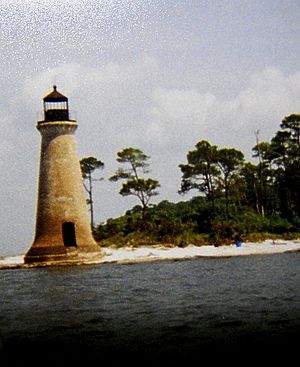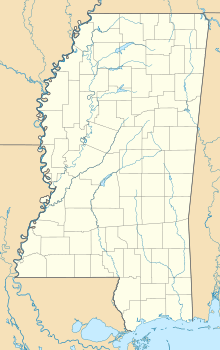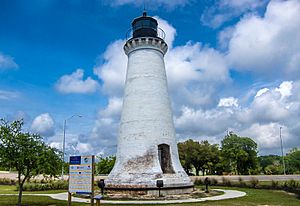Round Island Light, Mississippi facts for kids
 |
|
| Round Island Lighthouse, 1998. Original coordinates 30°17′31″N 88°35′12″W / 30.2919°N 88.5867°W | |
|
|
|
| Location | Pascagoula, Mississippi |
|---|---|
| Coordinates | 30°22′15″N 88°33′21″W / 30.37070°N 88.55590°W (2013) |
| Year first lit | 1859 |
| Automated | 1944 |
| Deactivated | 1949 |
| Foundation | Unknown |
| Construction | Brick |
| Tower shape | Conical |
| Markings / pattern | Red Brick |
| Height | 50 feet (15 m) |
| Original lens | fourth order Fresnel lens |
| Range | 10–12 nautical miles; 19–23 kilometres (12–14 mi) |
| ARLHS number | USA-711H |
The Round Island Lighthouse was a historic lighthouse that stood from 1859 to 1998. It was located on the southwest end of Round Island in the Mississippi Sound. This island is about 4 miles (6.4 km) south of Pascagoula, Mississippi.
Sadly, in September 1998, a powerful storm called Hurricane Georges knocked the lighthouse down. Later, in 2010, parts of the lighthouse, including its base, were moved from Round Island. They were brought to the city of Pascagoula to be fixed up and rebuilt.
Contents
The Story of Round Island Lighthouse
Building the First Lighthouse
In 1833, the United States Lighthouse Board decided to build a lighthouse on Round Island. This was to help ships navigate the Mississippi Sound. However, by 1854, they realized the lighthouse was not built very well. It was also too close to the water, which was causing its base to wear away.
Building the Second Lighthouse
Because of the problems with the first lighthouse, a new one was planned. A second lighthouse and a home for the lighthouse keeper were built. This project was finished in 1859 and cost $7,130.97.
The lighthouse built in 1859 was 50 feet (15 meters) tall. Its light was 44 feet (13 meters) above sea level. It used a special Fresnel lens (a type of lens that makes light brighter and more focused). This light could be seen from 12 to 14 miles (19 to 23 km) away.
How the Lighthouse Worked
For many years, lighthouses used different types of oil to create their light. These included sperm oil, rapeseed oil, lard, and kerosene. Most lighthouses switched to electric power in the 1920s.
During the American Civil War (1861-1865), soldiers from the Confederate States of America took the Fresnel lens from the Round Island Lighthouse. They moved it to Montgomery, Alabama to keep it safe from harm.
Lighthouse Automation and Deactivation
The Round Island Lighthouse became automated in 1944. This meant it no longer needed a keeper to operate it. However, it was turned off just five years later, in 1949.
After it was turned off, the United States Coast Guard still used the lighthouse. Until 1954, they kept it as a "day beacon." This meant it was a landmark for ships during the day, but it did not have a light at night. The lighthouse was mainly important for guiding ships into Pascagoula Harbor.
In 1955, the lighthouse, its dwelling, and other buildings were declared extra property by the government. Over the years, the lighthouse suffered from damage caused by people and ocean waves. In 1986, the lighthouse and about 50 acres (20 hectares) of land were given to the City of Pascagoula. The lighthouse was added to the National Register of Historic Places on October 9, 1986.
What Happened to the Lighthouse?
In September 1998, Hurricane Georges hit the area and knocked down the Round Island Lighthouse. There were plans to rebuild it in its original spot on Round Island, and work even started.
However, in August 2005, another powerful storm, Hurricane Katrina, struck. It destroyed the lighthouse that was being rebuilt.
Because Round Island was so exposed to storms and erosion, the Pascagoula City Council made a big decision. They decided to rebuild the lighthouse within the city of Pascagoula itself. They planned to use as many of the original parts as they could find from the island.
By 2012, the original base of the lighthouse and the fixed-up top section (called the lantern gallery) were secured at their new spot. This new location is just south of U.S. Route 90 in Pascagoula. By July 2014, the outside of the lighthouse was fully restored. The original lantern gallery was placed on top, bringing the lighthouse back to life in a new home.




